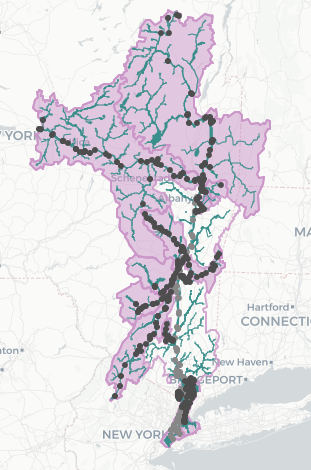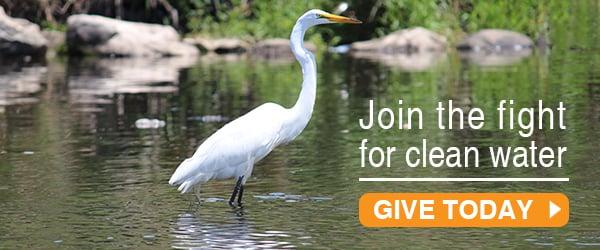Community Science Open Dataset
Since 2010, Riverkeeper has been advising, organizing, and assisting community scientists to collect Enterococcus (“Entero”) data from tributaries to, and local waterfront areas of, the Hudson River. We added E. coli in some areas in 2021. Entero and E. coli are fecal-indicator bacteria used to measure how safe water is for recreation. Riverkeeper’s community-based Entero monitoring started a regional movement. We and our network of partners have sampled the headwaters of the Hudson at Lake Tear of the Clouds in the Adirondacks, wastewater treatment plant outfalls, the kayak launches of New York Harbor, and many places in between. More than 50 academic, community and watershed groups, and hundreds of volunteers, have monitored approximately 400 locations in about two dozen waterways and waterfronts. Riverkeeper has relied heavily on these monitoring data in our state and local advocacy for clean water policies and funding. Some of the outcomes of this effort have included significant new investments in wastewater infrastructure.
 Riverkeeper’s community science mantra has long been, “Let the data do the talking.” As the managers of the region’s longest running and most spatially expansive Entero dataset, we are now using our platform to make much of this dataset more easily accessible so that the data may continue talking. This dataset includes information from Bronx River (collected by Bronx River Alliance), Catskill Creek, Esopus Creek, Pocantico River, Quassaick Creek (collected by Quassaick Creek Watershed Alliance), Rondout Creek, Saw Mill River (collected by Sarah Lawrence College Center for the Urban River at Beczak), Sawyer Kill, Sparkill Creek (collected in collaboration with Sparkill Creek Watershed Alliance), Upper Hudson River (collected in collaboration with the NATURE Lab at Media Sanctuary), and Wallkill River. Data from other areas in the watershed can be found at Bard Water Lab (Roe Jan Program and Saw Kill Program) and NYC Water Trail Association.
Riverkeeper’s community science mantra has long been, “Let the data do the talking.” As the managers of the region’s longest running and most spatially expansive Entero dataset, we are now using our platform to make much of this dataset more easily accessible so that the data may continue talking. This dataset includes information from Bronx River (collected by Bronx River Alliance), Catskill Creek, Esopus Creek, Pocantico River, Quassaick Creek (collected by Quassaick Creek Watershed Alliance), Rondout Creek, Saw Mill River (collected by Sarah Lawrence College Center for the Urban River at Beczak), Sawyer Kill, Sparkill Creek (collected in collaboration with Sparkill Creek Watershed Alliance), Upper Hudson River (collected in collaboration with the NATURE Lab at Media Sanctuary), and Wallkill River. Data from other areas in the watershed can be found at Bard Water Lab (Roe Jan Program and Saw Kill Program) and NYC Water Trail Association.
An open dataset means more students and researchers can explore questions about Enterococcus, sewage pollution, tributary ecology, and more. By putting the data into more hands, we hope that together we can put these data into action to build a better world for us all. Some of our research questions are:
-
- What comes to light when these data are analyzed through the lenses of environmental injustice or systemic racism?
- What are the relationships between fecal-indicator bacteria abundance and pathogen presence?
- How do fecal-indicator bacteria abundances relate to land use, season, population density, precipitation, wastewater infrastructure, or other factors?
- At any given location, what are the likeliest sources of fecal contamination?
- How do fecal-indicator bacteria abundances compare to each other, and what factors drive the differences?
- Do Entero and E. coli persist in sediment, and how does sediment resuspension affect fecal-indicator bacteria and pathogen abundances?
- How far are fecal-indicator bacteria transported before they die off, and how does this compare to pathogens?
- How does precipitation affect fecal-indicator bacteria abundance, and how does this vary with land use or precipitation history?
- What is the relationship between stream regulatory classifications and fecal-indicator bacteria abundance, and how does this explain the efficacy of Clean Water Act policies?
- How has Entero abundance changed over time? How do the observed changes relate to climate, infrastructure management, population, or other factors?
Our hope is that you share your results back with us so that we can continue to learn and be in conversation with you. Feel free to send your results to Sebastian Pillitteri or [email protected].
These data are shared under a Creative Commons Attribution-Noncommercial-ShareAlike 4.0 (CC BY-NC-SA 4.0) license. You are free to use, share, and adapt this work under the following conditions:
-
- You must give appropriate credit, provide a link to the license, and indicate if changes were made. You may do so in any reasonable manner, but not in any way that suggests the licensor endorses you or your use.
- You may not use the material for commercial purposes.
- If you remix, transform, or build upon the material, you must distribute your contributions under the same license as the original.
- You may not apply legal terms or technological measures that legally restrict others from doing anything the license permits.
- Permission to use the data does not mean that Riverkeeper endorses all uses or conclusions.
These data are from water samples provided by hundreds of samplers from throughout the Hudson River Watershed. If you use these data, we ask that you give credit by linking to our Community Attribution page to recognize the efforts of our dedicated volunteers.
Suggested citation format: Riverkeeper, Bronx River Alliance, Quassaick Creek Watershed Alliance, Sarah Lawrence College Center for the Urban River at Beczak (2022). Riverkeeper Hudson River Tributary Community Science Fecal Indicator Bacteria Dataset (v2), HydroShare, http://www.hydroshare.org/resource/e22138bd77914201af48fce5bfc458f4

